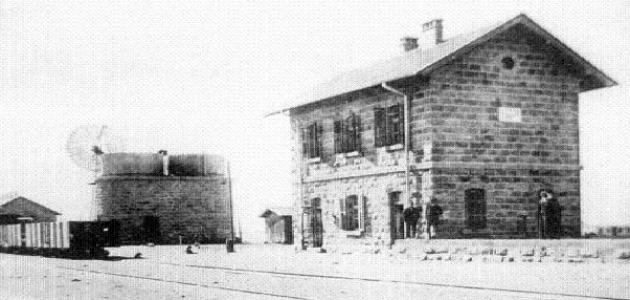Tabuk...a history and traces of a stab in the time
on- 2021-12-12 13:48:14
- 0
- 1720

Tabuk historical Castle and Ain Al Sukkar:
Tabuk Castle was established in the Abbasid era, then it was rebuilt in the era of Sultan Suleiman the Magnificent in 967 AH / 1599 CE, and rebuilt during the era of Sultan Muhammad IV in 1064 AH / 1653 CE. Renovation work was recorded on ceramic tiles above the entrance arch, and the history of this castle dates back more than 3500 years.
Sultan Muhammad Khan ordered the renewal and reconstruction of the Tabuk Citadel , then the castle was renewed in 1260 AH / 1844 CE during the era of Sultan Abdul Majeed Khan bin Mahmoud who wrote on that occasion an inscription placed over the mihrab of the Citadel Mosque .. In the Saudi era, the castle’s architecture was renewed in 1370 AH / 1950 CE.
Next to the castle is a semi-circular pool called “Ain al-Sukkar” . Its history is related to the Battle of Tabuk, that the Prophet, Peace be upon him , led, and the army camp was located around it. It was mentioned in the noble hadith that the Messenger, may peace be upon him, said to Muadh, may God be pleased with him: (Muadh, you if God prolonged your age , you are about to see this area full of gardens.)
The Supreme Commission for Tourism, Tabuk Branch, prepared and developed the area surrounding the castle, where an ornamental fence was placed around the ponds and spring area "Ain al-Sukkar", a gate for entry, corridors were paved, places to sit inside the castle, and visitors were introduced to the importance and position of this castle.
The Supreme Commission for Tourism, in cooperation with the Antiquities Office in Tabuk region, organizes trips to Tabuk Castle. A number of intellectuals and writers visited this castle, as well as European groups that visit the region to see the region’s antiquities, including this castle, in which many photograph inside This castle, which includes the prison mosque, a well, and guest rooms in the past
It has the creativity of construction and the beauty of the distinctive architectural style with hollow stones from the inside, which consists of three floors that can be accessed through stairs built of stones and fitted with openings that were used in the past for observation, and next to this castle is «Ain al-Sukkar» spring which witnesses to the invasion of Tabuk, which is considered the most famous and the oldest is in Tabuk . «Ain al-Sukkar» was the only source of watering and irrigation for agriculture around the castle.
Al-Muadam Historical Castle and Pool:
It is a wide well designed pool built with stone, plaster, so that torrents enter it from the four sides on rainy days, and water lasts for a period. It was built by the great king of (Aleppo) for pilgrims.
In the year 1040 AH, Muhammad Kabrit al-Musawi al-Madani passed by with the caravan of Hajj al-Sham, and he said: Then we came to al-Al-Muadam , which is a valley in which an Ottoman casstle was built in s thirty-one and a thousand years old, but there was no water in that castell, and I was about to die, in this regard, some of them say: Oh, the great! you have cruelty ... so for what reason you have been nicknamed the great? The great is the one who help his visitors... I see that you about to kill those people because of thirst. then at the castle there is a great and very wide pool, the water comes to it from the rain, and it has twenty-five degrees, when we came to it we found fifteen degrees of it in the fresh water.
Haji Khalifa 1045 AH says:
Al-Muadam pond:
It is a large basin built to be filled with torrential water and to remain empty when the rains ceased.
Description of the pond
When we visited it in 1427: The pond is square and the length of the side is 60 meters, the pond is deep. We could not measure the depth because it was half-full of water, and the camel shepherd told us that this is a remnant of the torrent last year! There is a stone staircase going down to the pool.
In general, Al-Muadam pond is still in excellent condition and still serves the purpose of its existence, but the funny thing is that the Bedouins still benefit from it, there is a motor to draw water to water camels. One of the reasons for building the great castle in the year 1031 AH is to protect the pool from spoilers and to be an oasis of supply in the difficult wilderness that was called the Great Mafaza Between Tabuk and Al-Ula, but unfortunately, this castle has not succeeded, and I think that one of the most important reasons is that the well and the pool depend on rain, so if it dries up, the guards of the castle are left with no source of water, just as the castle is far from any metropolis or country, so its guards are at the mercy of the Bedouins after the return of the Hajj caravan It was abandoned and only used a few years dispersed over the four centuries that represent its age.
Hejaz railway line:
It was previously extended, originally designed to speed up the travel of Muslim pilgrims from Damascus to the holy cities of Mecca and Medina, but it ended up in ruins within less than two decades after its inception. Its remains covered in sunlight can be seen today, as it goes through northwestern Saudi Arabia in the form of dusty and sand-covered railways line, deserted stations and rusted locomotives.
The railway was originally created to link Constantinople and the Hijaz region in Saudi Arabia, the home to Islam's holiest sites, and shorten the journey of pilgrims performing the Hajj. The line, which began in 1900, had extended 1,600 kilometers from Syria to Medina by 1908, although the last planned station to Mecca was never established.
During World War I, portions of the line were attacked by Thomas Edward Lawrence and his Arab allies and by 1918, less than two decades after the start of the project, the railroad had been converted into rubble. The route was unofficially abandoned by 1920.
Ruins of Hejaz Railway:
The largest part of the railway remains can be reached in Medina and Tabuk, where the largest stations of the line were constructed and have since been restored. The addition of locomotives and information centers helps visitors learn about the railway's short and sad history.
The museum, which is located in the station with an Edwardian architectural style, to see its treasures of artifacts, manuscripts and photographs from this era, some from the railroad era and others from earlier. In the far north of Tabuk, you will find one of the best preserved examples of a station, and it includes a restored locomotive, freight wagon, as well as other artifacts.
Prince Fahd Bin Sultan Avenue:
It is considered a cultural landmark in the city of Tabuk and an important commercial center that witnesses a very large commercial movement throughout the day, and the avenue is the main artery of the city of Tabuk, but rather of the Tabuk region, due to the presence of all that a person needs to shop, whether alone or with his family.
There are many clothing stores for men, women and children on the avenue, shops selling jewelry and luxuries, stores selling sports equipment, pharmacies, foodstuff stores, watch sales, perfumery stores, a number of restaurants, hotels, buffets, refreshment stores, children's play stores, public acquisitions, and headquarters for branches of major banks.
Prince Fahd Bin Sultan Avenue is located in the city center of Tabuk, where many neighborhoods of the city are located. This avenue was previously known as the Main Street. Its length extends nearly six hundred meters. Before that, this avenue witnessed the entry of cars and pedestrians, which caused the occurrence of many traffic accidents and violations that were disturbing Avenue goers.
